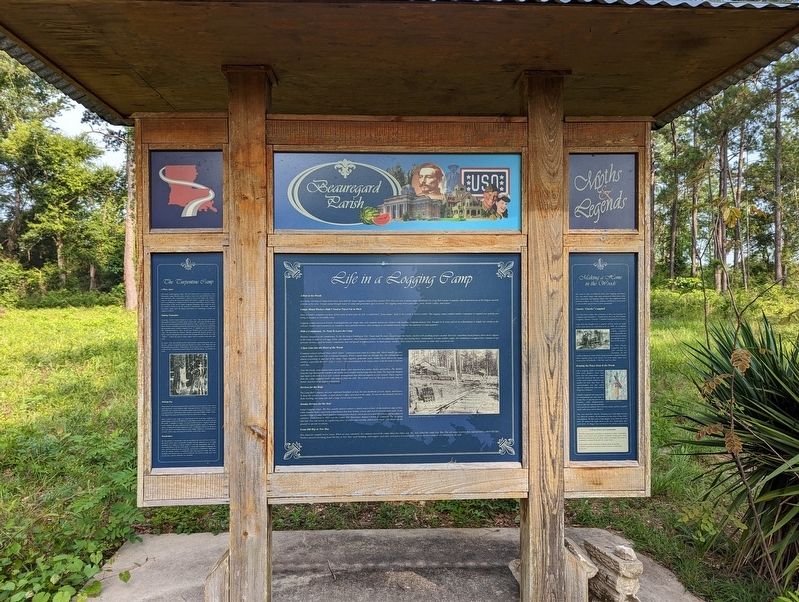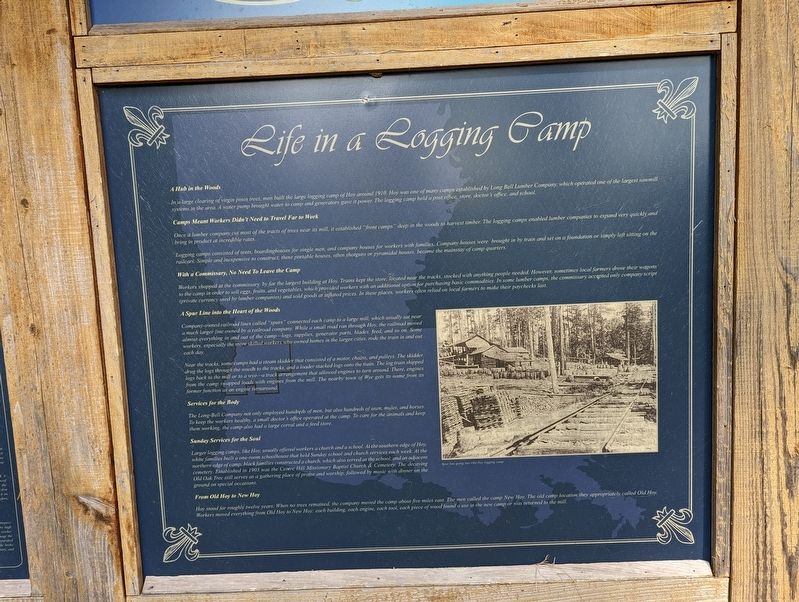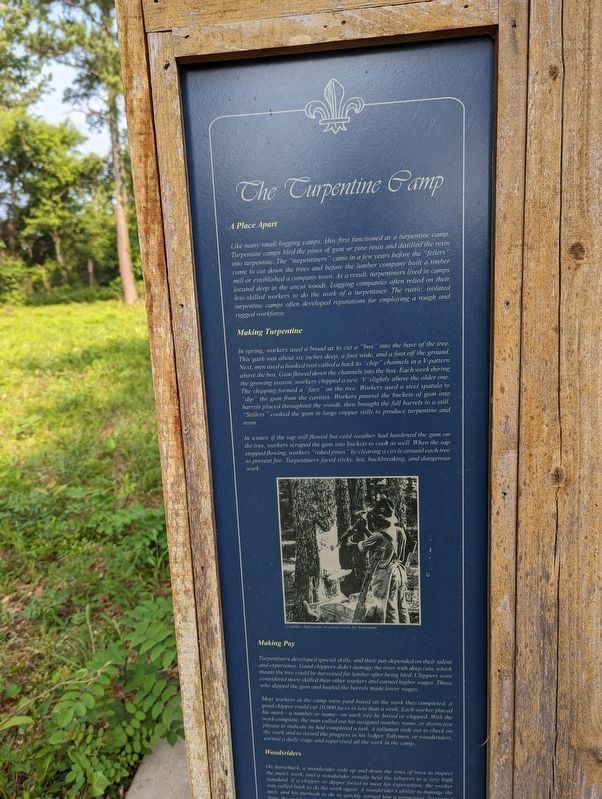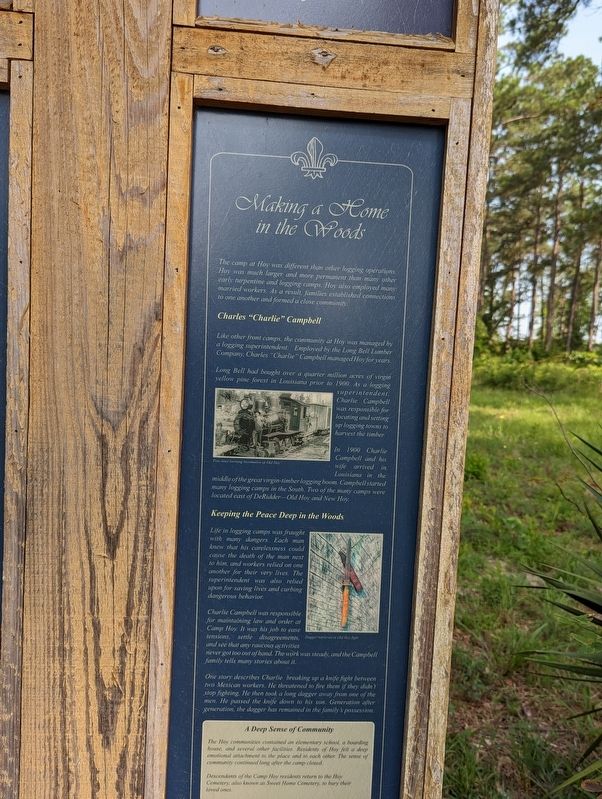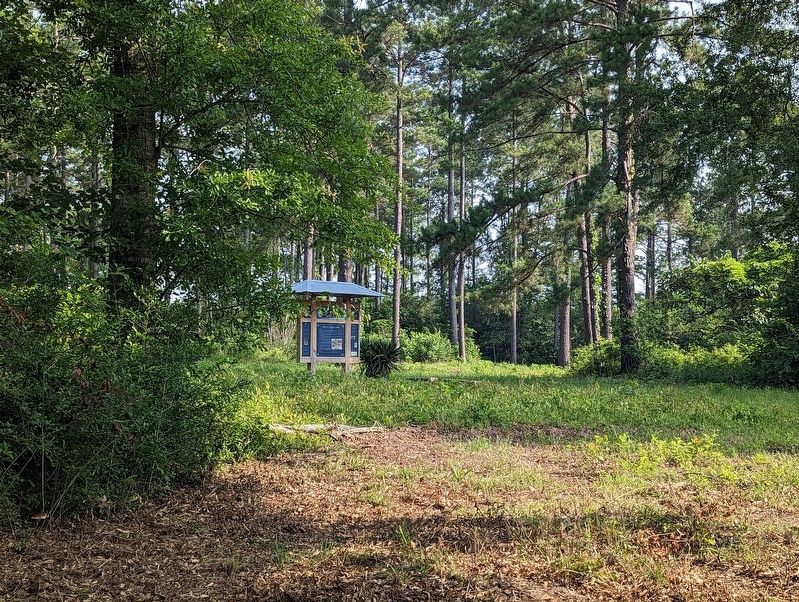Old Hoy in DeRidder in Beauregard Parish, Louisiana — The American South (West South Central)
Life in a Logging Camp
Louisiana Myths and Legends Byway
— Beauregard Parish —
A Hub in the Woods
In a large clearing of virgin pines trees, men built the large logging camp of Hoy around 1910. Hoy was one of many camps established by Long Bell Lumber Company, which operated one of the largest sawmill systems in the area. A water pump brought water to camp and generators gave it power. The logging camp held a post office, store, doctor's office, and school.
Camps Meant Workers Didn't Need to Travel Far to Work
Once a lumber company cut most of the tracts of trees near its mill, it established "front camps" deep in the woods to harvest timber. The logging camps enabled lumber companies to expand very quickly and bring in product at incredible rates.
Logging camps consisted of tents, boardinghouses for single men, and company houses for workers with families. Company houses were brought in by train and set on a foundation or simply left sitting on the railcars. Simple and inexpensive to construct, these portable houses, often shotguns or pyramidal houses, became the mainstay of camp quarters.
With a Commissary, No Need To Leave the Camp
Workers shopped at the commissary, by far the largest building at Hoy. Trains kept the store, located near the tracks, stocked with anything people needed. However, sometimes local farmers drove their wagons to the camp in order to sell eggs, fruits, and vegetables, which provided workers with an additional option for purchasing basic commodities. In some lumber camps, the commissary accepted only company script (private currency used by lumber companies) and sold goods at inflated prices. In these places, workers often relied on local farmers to make their paychecks last.
A Spur Line into the Heart of the Woods
Company-owned railroad lines called "spurs" connected each camp to a large mill, which usually sat near a much larger line owned by a railroad company. While a small road ran through Hoy, the railroad moved almost everything in and out of the camp-logs, supplies, generator parts, blades, feed, and so on. Some workers, especially the more skilled workers who owned homes in the larger cities, rode the train in and out each day.
Near the tracks, some camps had a steam skidder that consisted of a motor, chains, and pulleys. The skidder drug the logs through the woods to the tracks, and a loader stacked logs onto the train. The log train shipped logs back to the mill or to a wye-a track arrangement that allowed engines to turn around. There, engines from the camp swapped loads with engines from the mill. The nearby town of Wye gets its name from its former function as an engine turnaround.
Services for the Body
The Long-Bell Company not only employed hundreds of men, but also hundreds of oxen, mules, and horses. To keep the workers healthy, a small doctor's office operated at the camp. To care for the animals and keep them working, the camp also had a large corral and a feed store.
Sunday Services for the Soul
Larger logging camps, like Hoy, usually offered workers a church and a school. At the southern edge of Hoy, white families built a one-room schoolhouse that held Sunday school and church services each week. At the northern edge of camp, black families constructed a church, which also served as the school, and an adjacent cemetery. Established in 1903 was the Centre Hill Missionary Baptist Church & Cemetery. The decaying Old Oak Tree still serves as a gathering place of praise and worship, followed by music with dinner on the ground on special occasions.
From Old Hoy to New Hoy
Hoy stood for roughly twelve years. When no trees remained, the company moved the camp about five miles east. The men called the camp New Hoy. The old camp location they appropriately called Old Hoy. Worker's moved everything from Old Hoy to New Hoy: each building, each engine, each tool, each piece of wood found a use in the new camp or was returned to the mill.
The Turpentine Camp
Like many small logging camps, Hoy first functioned as a turpentine camp. Turpentine camps bled the pines of gum or pine resin and distilled the resin into turpentine. The "turpentiners" came in a few years before the "fellers" came to cut down the trees and before the lumber company built a timber mill or established a company town. As a result, turpentiners lived in camps located deep in the uncut woods. Logging companies often relied on their less-skilled workers to do the work of a turpentiner. The rustic, isolated turpentine camps often developed reputations for employing a rough and rugged workforce.
Making Turpentine
In spring, workers used a broad ax to cut a "box" into the base of the tree. This gash was about six inches deep, a foot wide, and a foot off the ground. Next, men used a hooked tool called a hack to "chip" channels in a V-pattern above the box. Gum flowed down the channels into the box. Each week during the growing season, workers chipped a new 'V'slightly above the older one. The chipping formed a "face" on the tree. Workers used a steel spatula to "dip" the gum from the cavities. Workers poured the buckets of gum into barrels placed throughout the woods, then brought the full barrels to a still. "Stillers" cooked the gum in large copper stills to produce turpentine and resin. In winter, if the sap still flowed but cold weather had hardened the gum on !the tree, workers scraped the gum into buckets to cook as well. When the sap stopped flowing, workers "raked pines" by clearing a circle around each tree to prevent fire. Turpentiners faced sticky, hot, backbreaking, and dangerous work.
Making Pay
Turpentiners developed special skills, and their pay depended on their talent and experience. Good chippers didn't damage the trees with deep cuts, which meant the tree could be harvested for lumber after being bled. Chippers were considered more skilled than other workers and earned higher wages. Those who dipped the gum and hauled the barrels made lower wages. Most workers at the camp were paid based on the work they completed. A good chipper could cut 10,000 faces in less than a week. Each worker placed his mark- -a number or name on each tree he boxed or chipped. With the work complete, the man called out his assigned number, name, or distinctive phrase to indicate he had completed a task. A tallyman rode out to check on the work and to record the progress in his ledger. Tallymen, or woodsriders, earned a daily wage and supervised all the work in the camp.
Woodsriders
On horseback, a woodsrider rode up and down the rows of trees to inspect the men's work, and a woodsrider usually held the laborers to a very high standard. If a chipper or dipper failed to meet his expectation, the worker was called back to do the work again. A woodsrider's ability to manage the men, and his methods to do so quickly earned him a reputation. Separated from the outside world, a woodsrider also kept peace at camp. He broke up fights and docked pay for unruly behavior. He stood as judge, jury, and executioner, and his authority was absolute.
Making a Home in the Woods
The camp at Hoy was different than other logging operations. Hoy was much larger and more permanent than many other early turpentine and logging camps. Hoy also employed many married workers. As a result, families established connections to one another and formed a close community.
Charles "Charlie" Campbell
Like other front camps, the community at Hoy was managed by a logging superintendent. Employed by the Long Bell Lumber Company, Charles "Charlie" Campbell managed Hoy for years. Long Bell had bought over a quarter million acres of virgin yellow pine forest in Louisiana prior to 1900. As a logging superintendent, Charlie Campbell was responsible for locating and setting up logging towns to harvest the timber. In 1900 Charlie Campbell and his wife arrived in Louisiana in the middle of the great virgin-timber logging boom. Campbell started many logging camps in the South. Two of the many camps were located east of DeRidder-Old Hoy and New Hoy.
Keeping the Peace Deep in the Woods
Life in logging camps was fraught with many dangers. Each man knew that his carelessness could cause the death of the man next to him, and workers relied on one another for their very lives. The superintendent was also relied upon for saving lives and curbing dangerous behavior.
Charlie Campbell was responsible for maintaining law and order at Camp Hoy. It was his job to ease tensions, settle disagreements, and see that any raucous activities never got too out of hand. The work was steady, and the Campbell family tells many stories about it.
One story describes Charlie breaking up a knife fight between two Mexican workers. He threatened to fire them if they didn't stop fighting. He then took a long dagger away from one of the men. He passed the knife down to his son. Generation after generation, the dagger has remained in the family's possession.
Erected by State of Louisiana. (Marker Number 12.)
Topics. This historical marker is listed in these topic lists: Cemeteries & Burial Sites • Horticulture & Forestry • Settlements & Settlers.
Location. 30° 47.815′ N, 93° 4.083′ W. Marker is in DeRidder, Louisiana, in Beauregard Parish. It is in Old Hoy. Marker can be reached from Old Hoy Cemetery Road, 0.3 miles north of Louisiana Highway 26, on the right when traveling north. Touch for map. Marker is at or near this postal address: 5891 LA-26, Deridder LA 70634, United States of America. Touch for directions.
Other nearby markers. At least 8 other markers are within 13 miles of this marker, measured as the crow flies. Sugartown (approx. 4.3 miles away); Old Camp Ground Cemetery (approx. 4.6 miles away); Old Campground (approx. 4.6 miles away); Shady Grove School/Community Building (approx. 6.4 miles away); Gravehouses of Talbert-Pierson Cemetery (approx. 6˝ miles away); Talbert-Pierson Cemetery (approx. 6˝ miles away); Fullerton (approx. 12 miles away); Religion in the Neutral Strip (approx. 12.4 miles away). Touch for a list and map of all markers in DeRidder.
More about this marker. Hoy Cemetery Road is also a driveway. Please be cautious.
Credits. This page was last revised on July 23, 2023. It was originally submitted on July 23, 2023, by Cajun Scrambler of Assumption, Louisiana. This page has been viewed 149 times since then and 47 times this year. Photos: 1, 2, 3, 4, 5. submitted on July 23, 2023, by Cajun Scrambler of Assumption, Louisiana.
